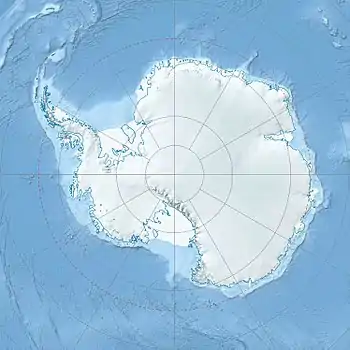Radok Lake
Radok Lake is a meltwater lake about four miles (6.4 km) long and marked by a slender glacier tongue feeding into it from the west, lying three miles (4.8 km) south-west of Beaver Lake and 15 miles (24 km) south-east of the Aramis Range, Prince Charles Mountains. It was plotted by Australian National Antarctic Research Expeditions (ANARE) from air photos taken by the RAAF Antarctic Flight in 1956. The lake was named for Uwe Radok, Reader (head) of Meteorology Dept at the University of Melbourne, who greatly assisted Australian National Antarctic Research Expeditions (ANARE)'s glaciological program.[1] With a depth of 362 metres (1,188 ft), Radok Lake is the deepest known lake on the Antarctic continent[2] and the only known freshwater lake to host a floating ice tongue glacier (the Battye Glacier).[3] It is drained by three-mile-long (4.8 km) Pagodroma Gorge in to Beaver Lake. Radok Lake is an isothermal and non-stratified Lake, i.e. homogeneous water body.[4]
| Radok Lake | |
|---|---|
 Radok Lake | |
| Location | Antarctica |
| Coordinates | 70°52′S 68°00′E |
| Type | meltwater lake |
Bainmedart Cove (70°51′S 68°3′E) is a cove about 1 nautical mile (2 km) long in eastern Radok Lake. The cove leads to the narrow Pagodroma Gorge. The name is a composite one made from the names of C. Bain, A. Medvecky, and J. Dart who spent a month at the cove studying the geology of the lakes area during the ANARE Prince Charles Mountains survey in January–February, 1969.
Pagodroma Gorge is a steep-sided gorge 3 mi long which joins Radok and Beaver Lakes. Photographed from ANARE aircraft in 1956. The gorge was traveled by A. Medvecky, ANARE geologist in January–February, 1969. Named by ANCA after the snow petrels (Pagodroma nivea) which nest in the weathered sandstone walls of the gorge.[5]
Glossopteris Gully (70°51′S 68°6′E) is a steep-sided, narrow gully on the east side of Bainmedart Cove. It was named by ANCA after the Glossopteris fossil plant found in the upper part of the gully.
Fossil Wood Point (70°50′S 68°2′E) is a point of land between Bainmedart Cove and Radok Lake. It was so named because deposits of fossil wood were found on the point.
Further reading
- Bernd Wagner, Holger Cremer, Limnology and Sedimentary Record of Radok Lake, Amery Oasis, East Antarctica, In: Fütterer D.K., Damaske D., Kleinschmidt G., Miller H., Tessensohn F. (eds) Antarctica PP 447–454. Springer, Berlin, Heidelberg, https://doi.org/10.1007/3-540-32934-X_57
- McKelvey, B., & Stephenson, N. A geological reconnaissance of the Radok Lake area, Amery Oasis, Prince Charles Mountains, Antarctic Science, 2(1), 53–66. https://doi.org/10.1017/S0954102090000062
- Wand U, Hermichen WD, Brüggemann E, Zierath R, Klokov VD. Stable isotope and hydrogeochemical studies of Beaver Lake and Radok Lake, MacRobertson Land, East Antarctica., Isotopes Environ Health Stud. 2011 Dec;47(4):407-14. https://doi.org/10.1080/10256016.2011.630465. Epub 2011 Nov 17.
- K.R. Walker and A. Mond, MICA LAMPROPHYRE (ALNOITE) FROM RADOK LAKE, PRINCE CHARLES MOUNTAINS, ANTARCTICA, RECORD 1911/108
External links
- Radok Lake on USGS website
- Radok Lake on AADC website
- Radok Lake on SCAR website
- Aerial photos of Radok Lake, Pagodroma Gorge and Beaver Lake
- Satellite image
References
- "Radok Lake". Geographic Names Information System. United States Geological Survey, United States Department of the Interior. Retrieved 2010-07-29.
- The Expeditions Amery Oasis, East Antarctica, in 2001/02 and Taylor Valley, Southern Victoria Land, in 2002 Archived 2011-07-24 at the Wayback Machine
- The Amery Oasis, Northern Prince Charles Mountains
- Wand U, Hermichen WD, Brüggemann E, Zierath R, Klokov VD. Stable isotope and hydrogeochemical studies of Beaver Lake and Radok Lake, MacRobertson Land, East Antarctica., Isotopes Environ Health Stud. 2011 Dec;47(4):407-14. https://doi.org/10.1080/10256016.2011.630465. Epub 2011 Nov 17.
- "Pagodroma Gorge". Geographic Names Information System. United States Geological Survey, United States Department of the Interior. Retrieved 2010-07-30.
![]() This article incorporates public domain material from websites or documents of the United States Geological Survey.
This article incorporates public domain material from websites or documents of the United States Geological Survey.